This tutorial on how to make Swiss Meringue buttercream is the only resource you’ll need to make the smoothest, silkiest frosting!
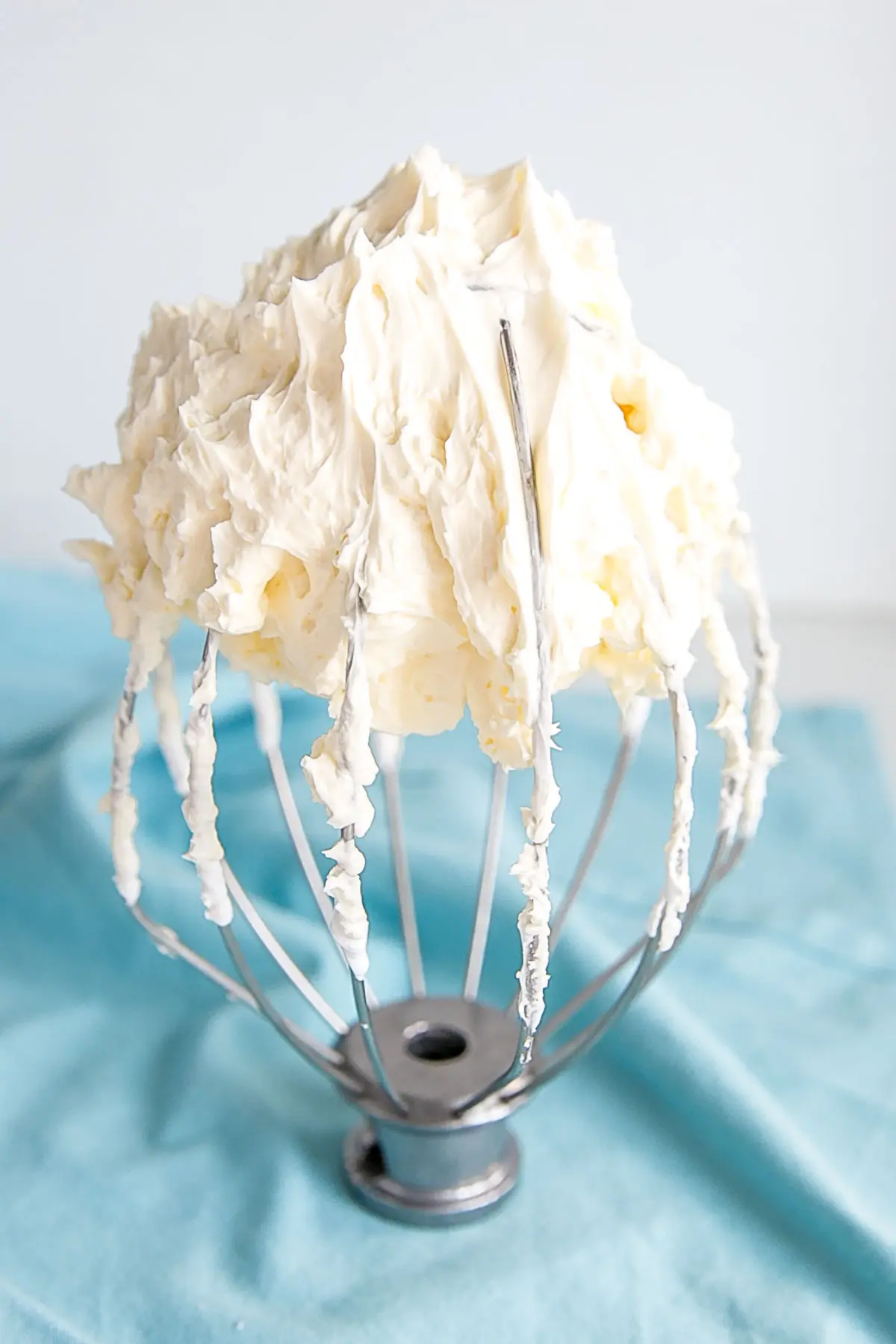
The topic of Swiss meringue buttercream comes up regularly in my Baking group on Facebook and in comments on some of my recipes here — how to make it, but more often how to deal with it when it’s just not cooperating.
Meringue buttercreams can be a bit temperamental, but whatever state you’ve got it in (provided you started with a stiff peak meringue) is totally saveable.
If you love Swiss meringue buttercream as much as I do, hopefully, you’ll find these tips useful.
If you’ve never tried it and are intimidated by it, I hope this tutorial will give you the confidence to give it a shot.
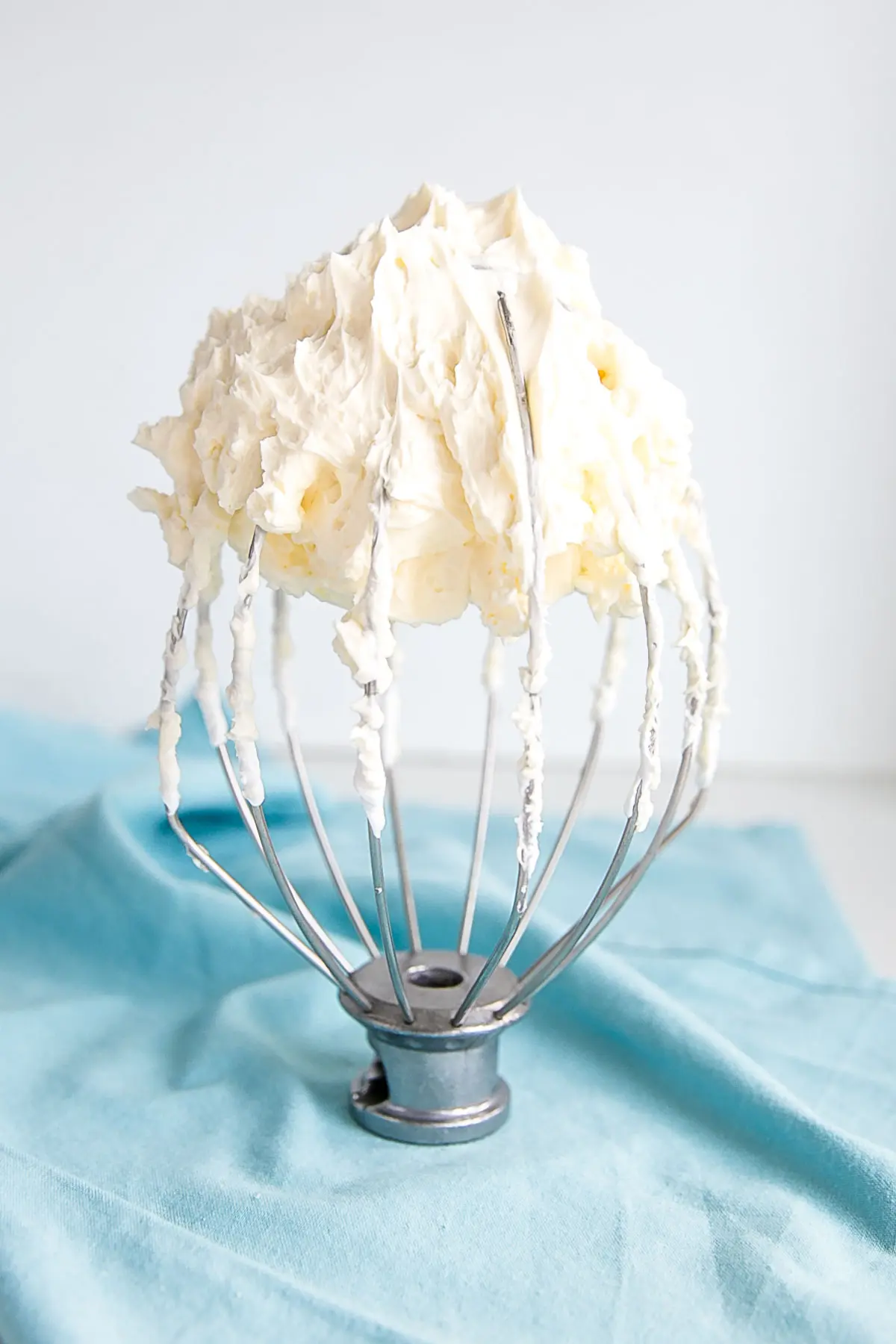
What is Swiss Meringue Buttercream?
Though more involved than an American buttercream, Swiss meringue buttercream (SMBC) is the easiest of the meringue buttercreams. It involves cooking eggs and sugar over a double boiler, whipping them into a meringue, then adding butter and flavorings.
The other two meringue buttercreams (Italian and French) both involve pouring boiling sugar into a partially whipped egg and sugar mixture.
They are equally delicious and known to be a bit more stable, but I find boiling sugar to be stressful and intimidating, so generally stay away from it as much as possible.
If you’re feeling adventurous though and you’ve tried SMBC before, I encourage you to give those a go and see how you like them.
Swiss meringue buttercream consists of 3 very simple ingredients:
- Egg whites
- Sugar
- Unsalted butter
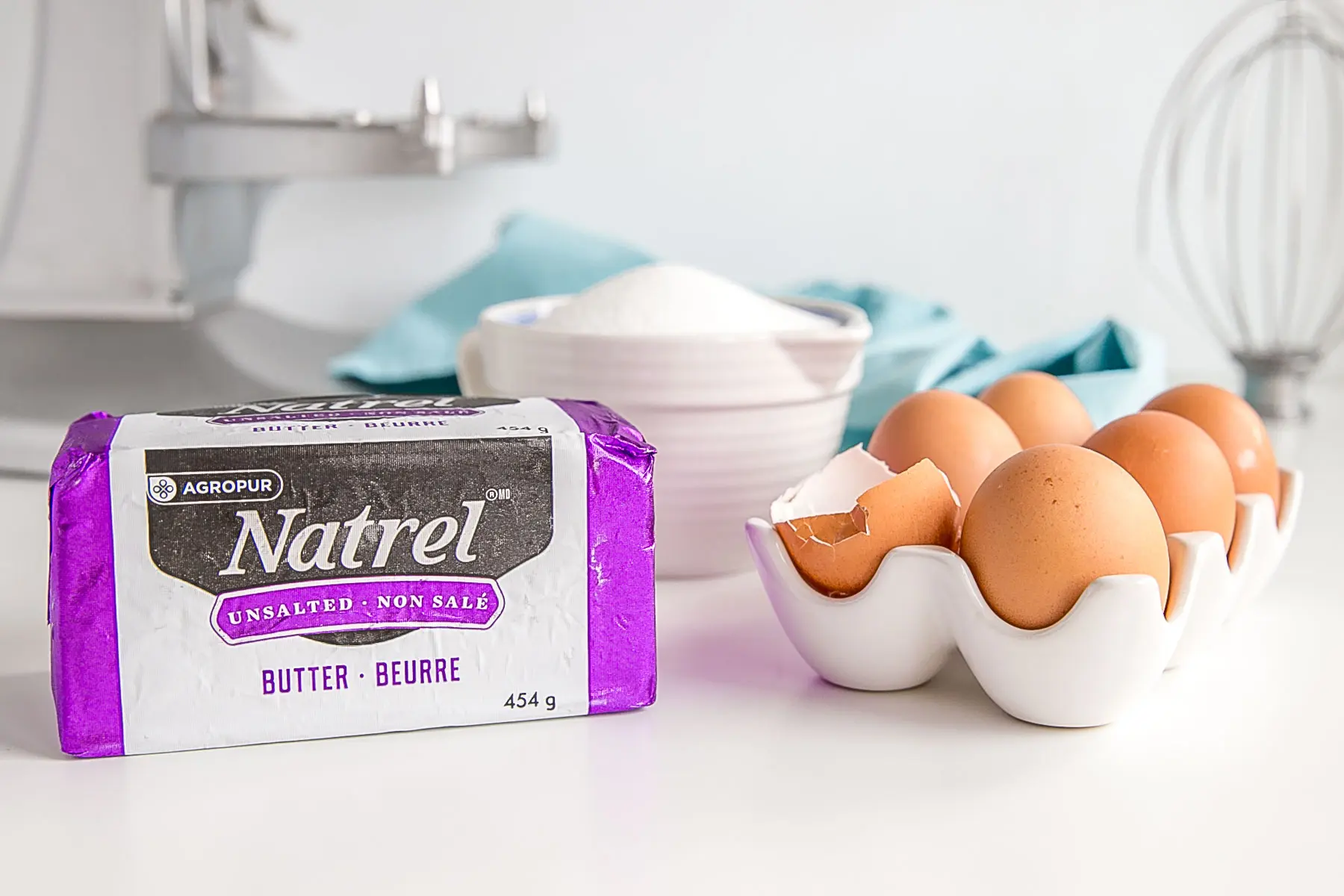
From there, you can flavor to your heart’s content. A simple and standard recipe will include vanilla, but the flavor possibilities are limited only by your imagination.
You can add melted chocolate for a milk, white, or dark chocolate Swiss meringue buttercream, freeze-dried berries for fruit flavor and color, peanut butter/peanut butter powder (preferred), or choose from a variety of flavorings to add in.
How to Make Swiss Meringue Buttercream
I’m going to take you through each step of the process here and call out tips or issues you may run into.
I recommend using a stand mixer for this buttercream. You likely could do it with a hand mixer, but it would be a more painful process — you’d be holding that hand mixer for a good 20+mins. As such, the steps I describe are for a stand mixer, but you can adapt to a hand mixer if that’s all you have to work with.
The very first thing you must do, this is NOT optional, is:
Step #1 – Wipe down all tools with lemon juice or vinegar
To help ensure a stable and stiff meringue, you must make sure that everything that will come in contact with the egg whites is completely grease-free. This includes things like your:
- mixer bowl
- whisk attachment
- hand whisk
- measuring cup (that will be used to scoop sugar)
- small bowl(s) (to crack eggs into when separating whites)
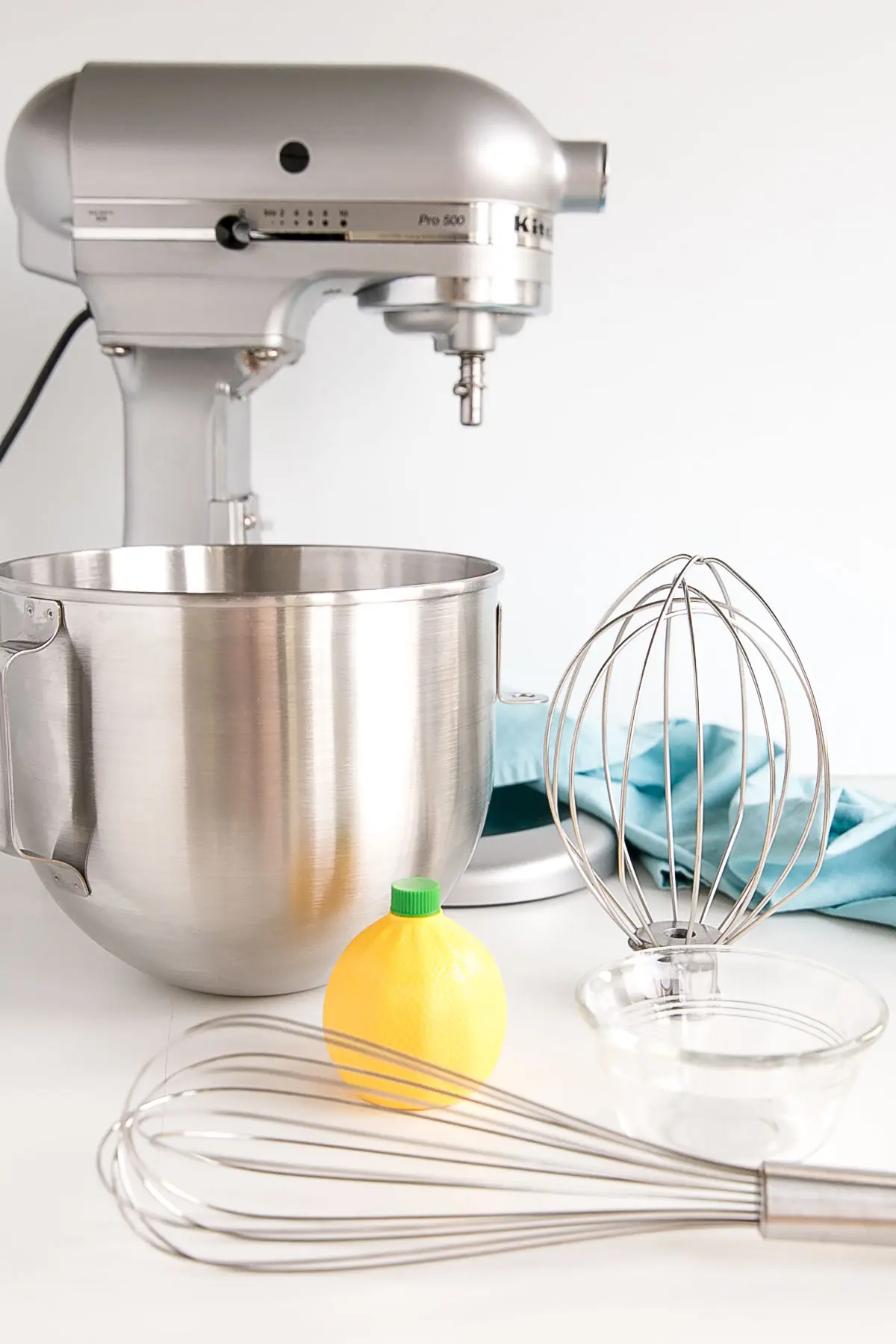
Grease is meringue’s enemy.
Even the tiniest speck of grease (or egg yolk) will cause the meringue to not whip to a stiff peak and result in a less-than-perfect (aka dense and greasy) Swiss meringue buttercream.
Another important tip here is to not use plastic tools, especially bowls, when making Swiss meringue. Plastic has a tendency to retain grease no matter how thoroughly it’s cleaned.
Best to be safe and stick to metal (preferred) or glass bowls.
Step #2 – Bring a medium pot of water to a simmer (1-2 inches of water)
You’ll want a pot that’s big enough to comfortably place your mixer bowl onto, but not so big that the bottom of the bowl touches the water.
You want a maximum of 1-2 inches of water in the pot. Bring this to a boil, then reduce to a low simmer.
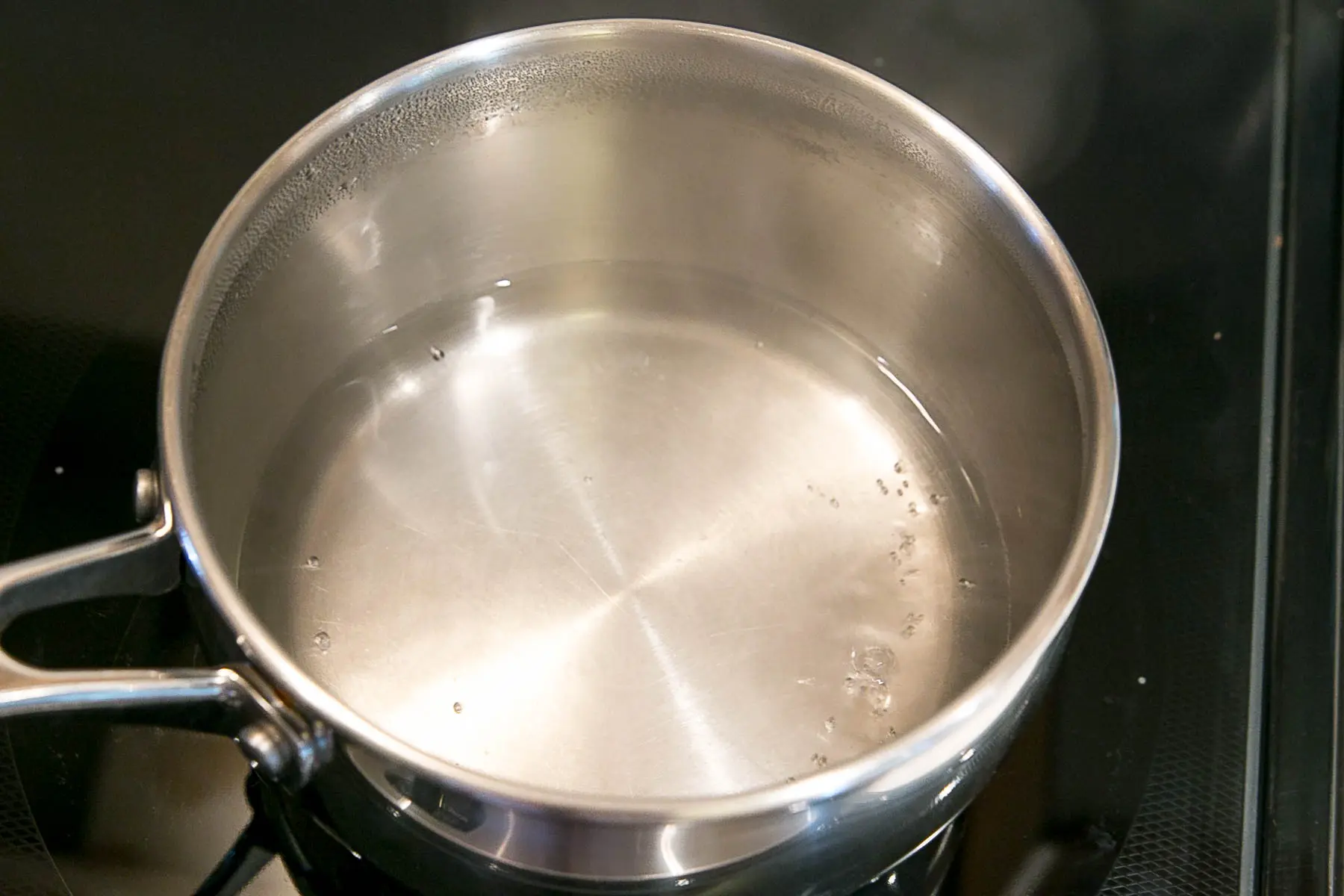
Step #3 – Separate your egg whites
Separate each egg white into a small bowl, then transfer into your mixer bowl.
Do not separate the egg whites directly into your mixer bowl. If you do that and have even one cracked yolk, you will ruin the whole batch of whites.
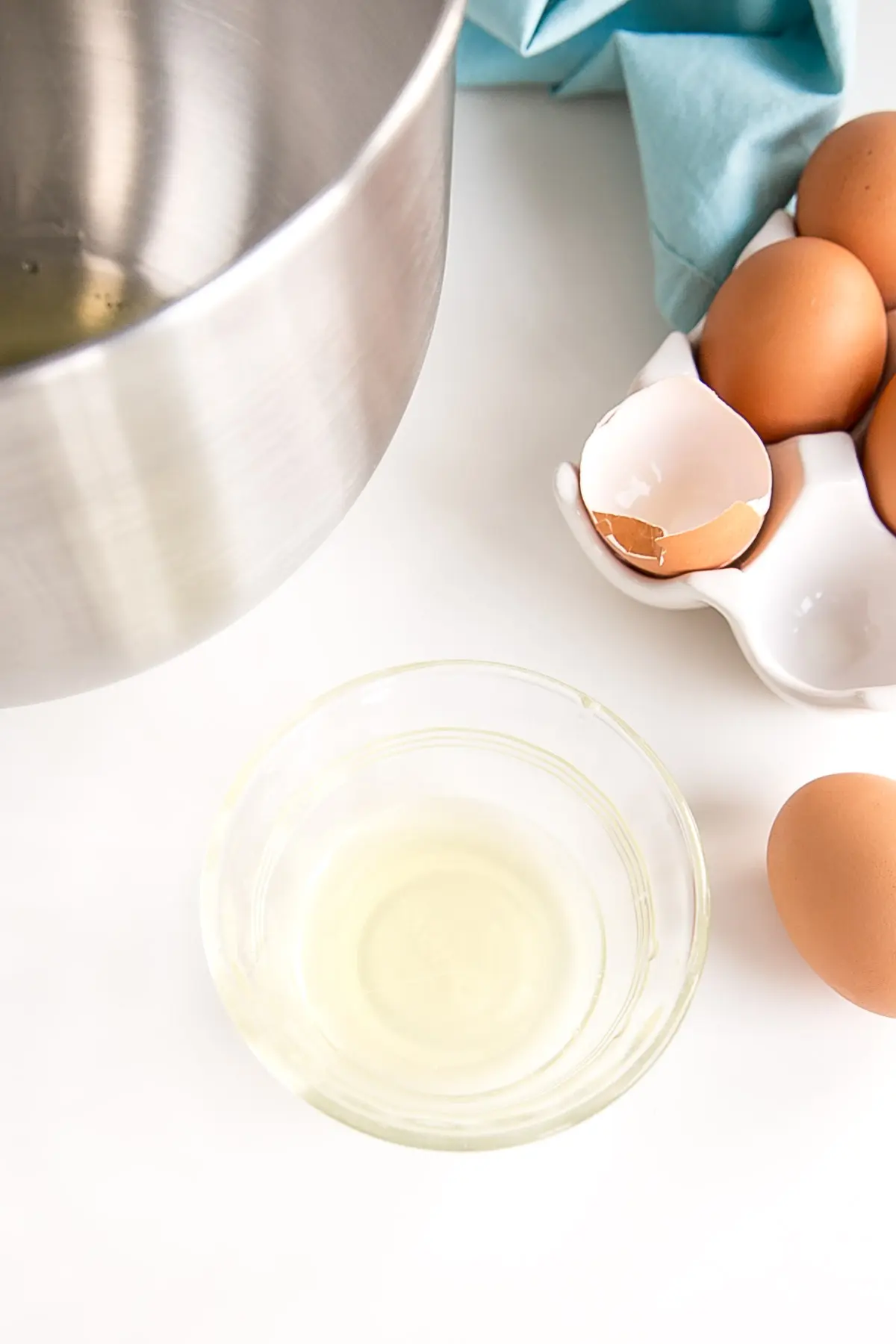
It’s best to separate each egg individually.
Even a speck of yolk will cause the meringue to not whip up properly. Do not attempt to make a meringue if your egg whites are not completely yolk-free.
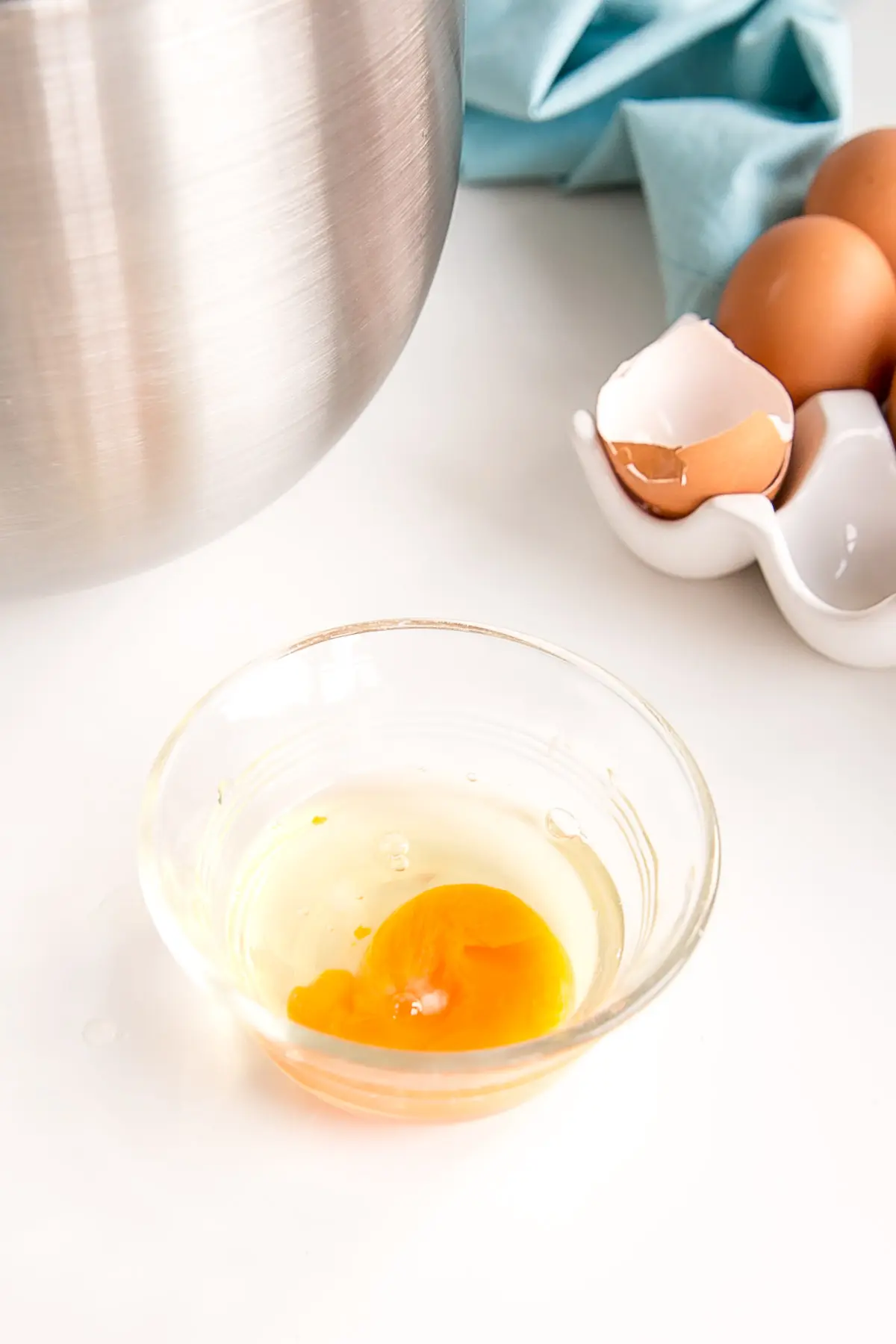
Note that the eggs do not need to be room temperature, since you’ll be cooking them anyhow.
Some people have had success with carton egg whites but, at this time, I cannot recommend them myself.
The carton whites I have tried have caused my meringue to stay flat and never stiffen. If you do want to experiment with carton whites, make sure the carton says something like “egg whites only” or similar.
Step #4 – Cook your egg whites & sugar
Once you’ve separated all your eggs, add them and your sugar into your mixer bowl and place it over the pot of simmering water.
I stir constantly at this point, with a clean hand whisk, to make sure the egg whites cook evenly. This process will take 2-3 mins depending on the number of egg whites you’re working with.
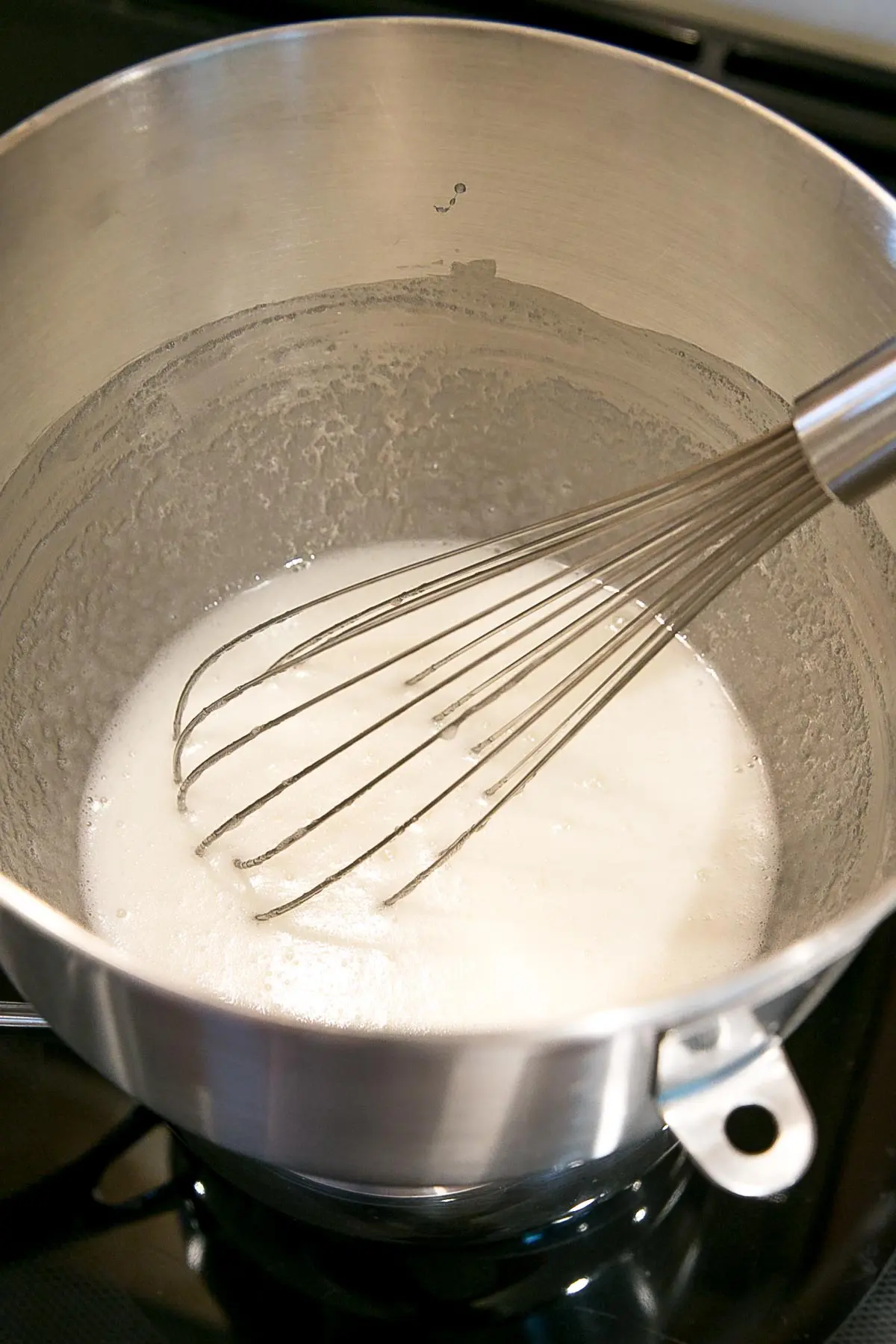
You’ll know the egg whites are done when the mixture is hot and no longer grainy to the touch.
I dip a (clean) finger into the mixture and rub it between my thumb and forefinger. If there is any graininess at all, I keep cooking them.
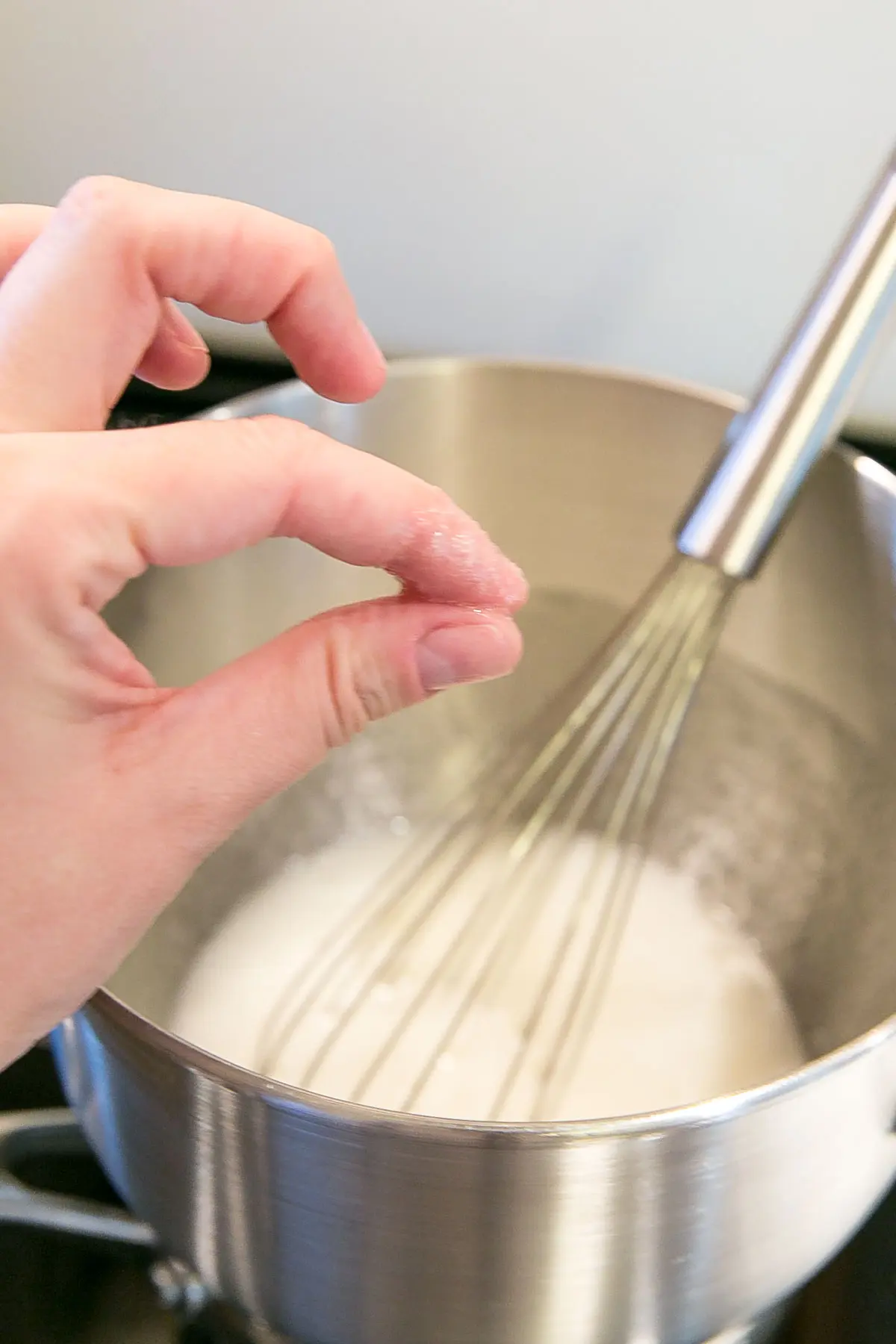
You want to make sure the mixture is hot to the touch too. Ideally, you’d use a candy thermometer to check that it has reached 160F. This is the most accurate way to make sure your whites are cooked fully.
I am too lazy to whip out a thermometer, and not concerned about eating raw eggs, so I do the touch test. If this is a concern for you, I recommend using a thermometer.
Step #5 – Whip your meringue
Remove your mixer bowl from the pot, wipe the bottom of the bowl, and place it on your stand mixer. Attach the whisk attachment and begin whipping.
I usually crank it right up to high speed (about 8-9 on my KitchenAid). You’ll want to whip this until the bowl is completely cool to the touch — this can take anywhere from 5-10mins.
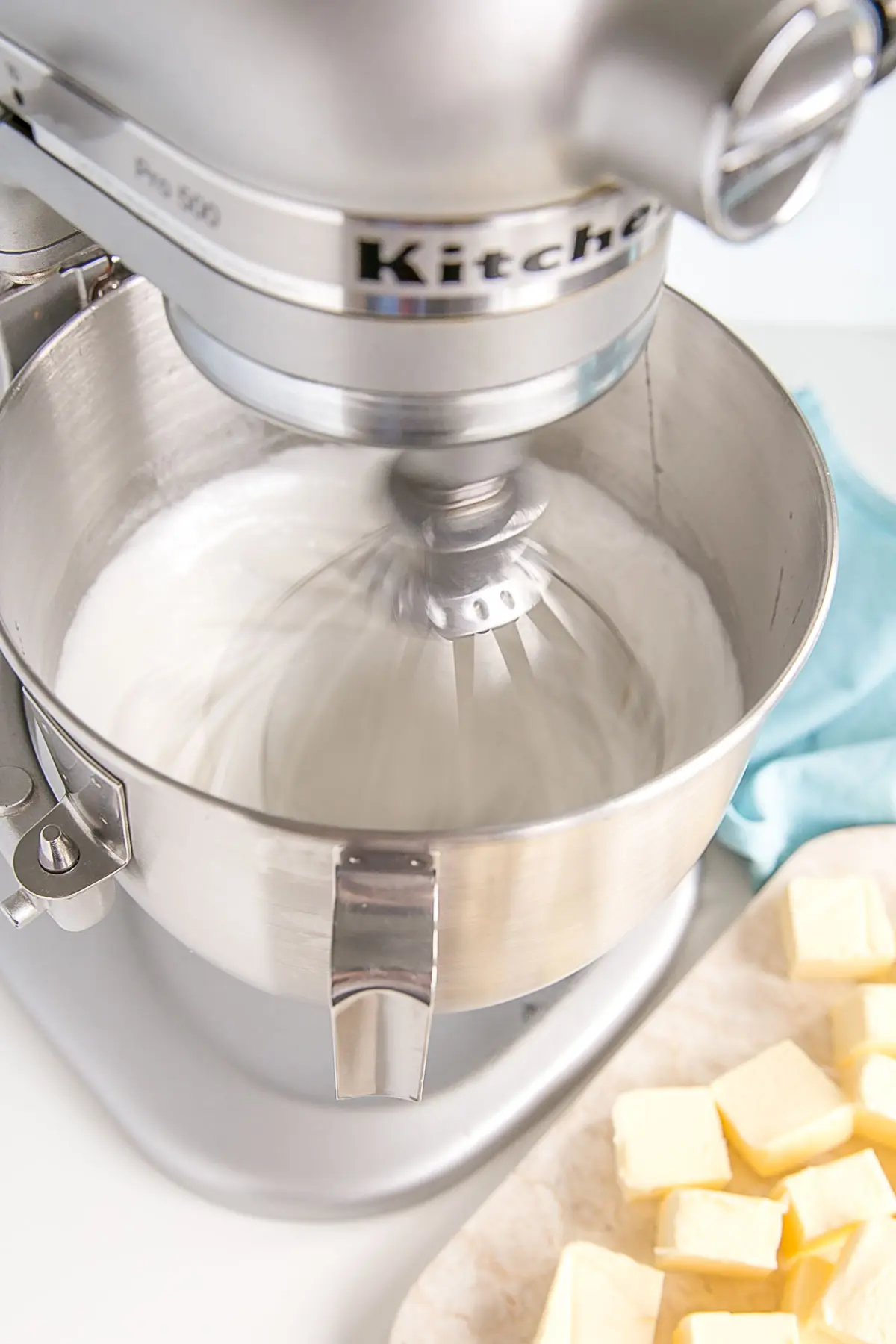
You’ll know if your meringue was successful if it holds a stiff peak. This is what it should look like – no droopy peaks!
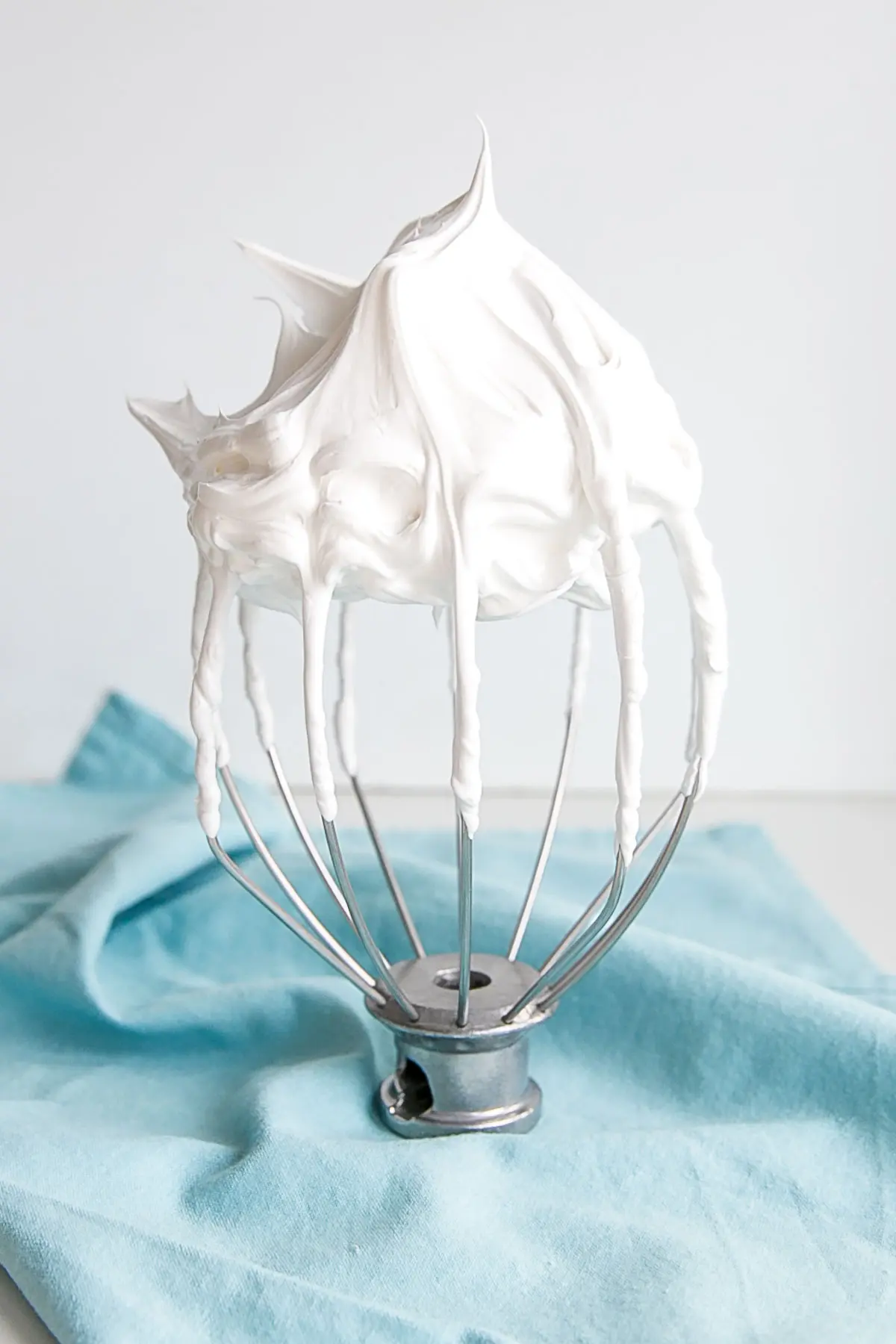
If your meringue is droopy, it was likely affected by either grease, yolk, or carton whites. See step #1. Unfortunately, if this happens, you will need to start over. There is no way to save the meringue at this point.
Step #6 – Cube your butter
While the meringue is whipping, cube your softened but still slightly cold butter. I roughly do 1″ or so cubes. It’s not an exact science, about 1 Tbsp or so each.
You will know your butter is the right consistency when you can press it with your finger and leave a bit of a dent in it.
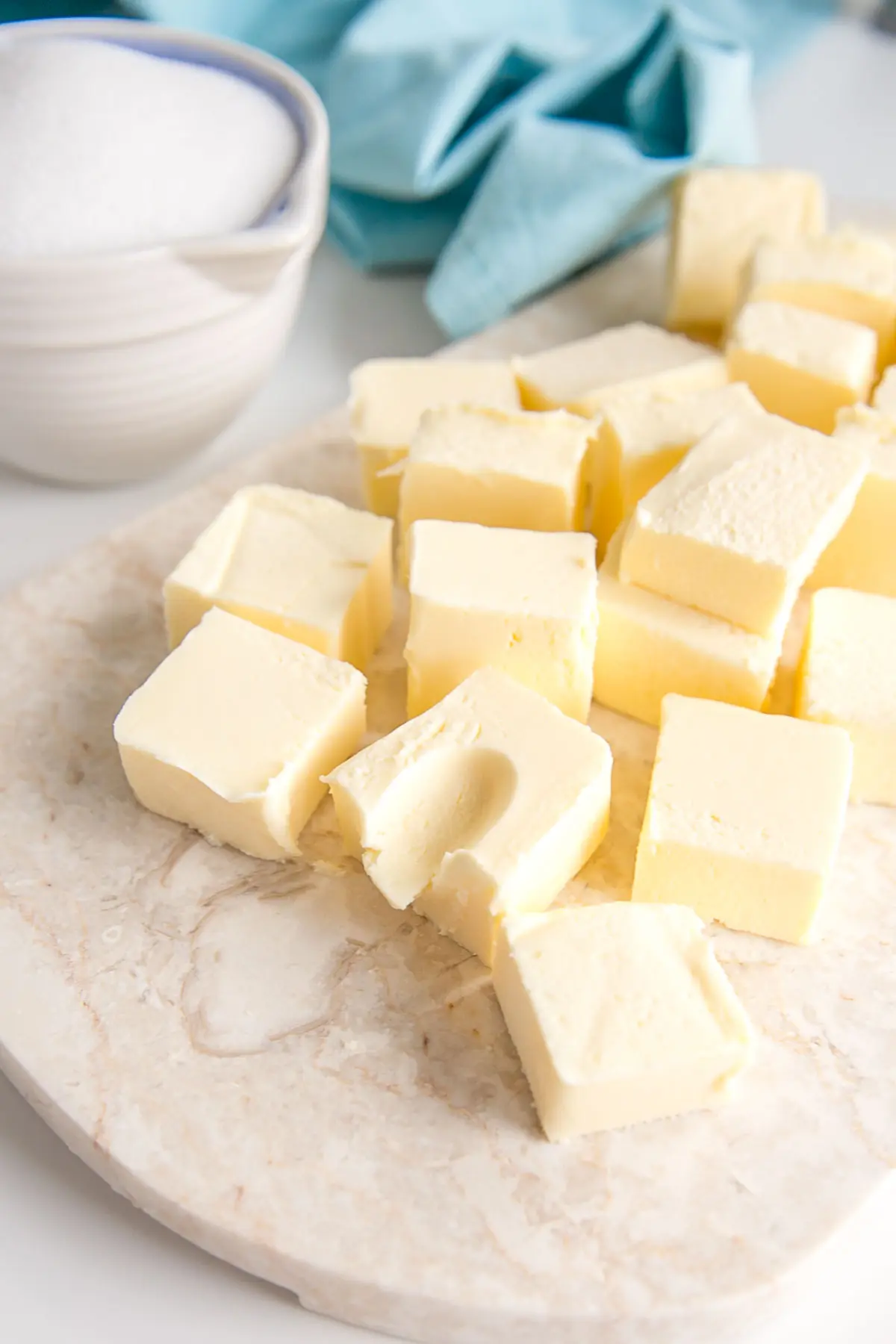
It’s important to note that your butter should not be too soft. If it’s so soft that you can press your finger through it easily, it will be too soft for your buttercream.
You can still use it, but you may need to chill your buttercream for a bit if it becomes soupy (see the Troubleshooting section below). I find it easier to deal with an SMBC that has used butter that’s too cold vs too soft.
Step #7 – Add the butter
When your meringue is completely cooled, stop your mixer and switch to the paddle attachment.
This isn’t critical, you can leave it on the whisk, but I like to switch to the paddle as I find that the whisk can incorporate too much air into the buttercream.
I also like that my paddle scrapes the sides of the bowl for me, which is a time saver.
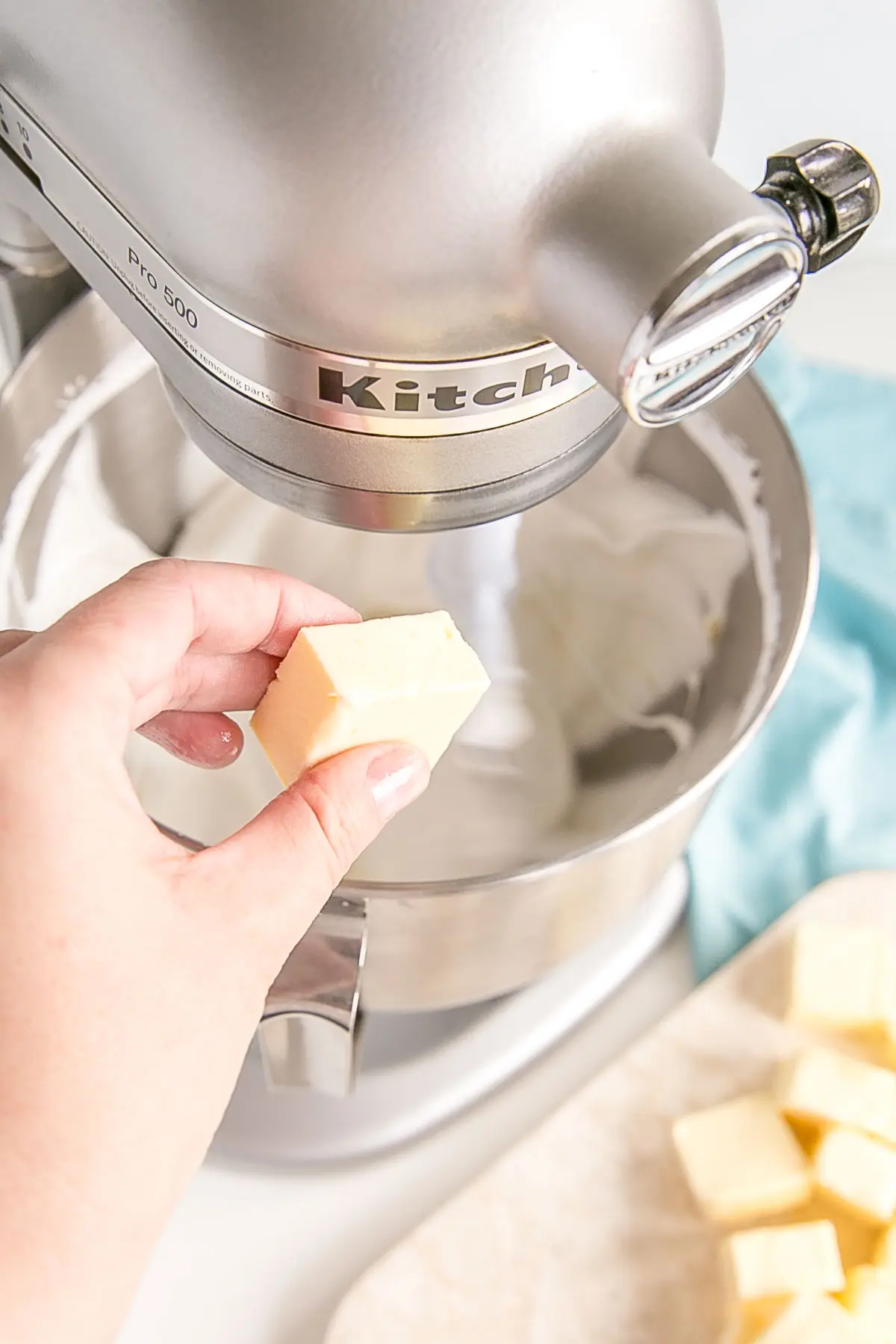
Set your mixer to medium speed (4 or so on a KitchenAid) and slowly start to add your butter cube by cube. Once all of the butter has been added, crank the mixer back up to high to beat the buttercream.
The buttercream can go through a few undesirable stages while it mixes. It can become soupy:
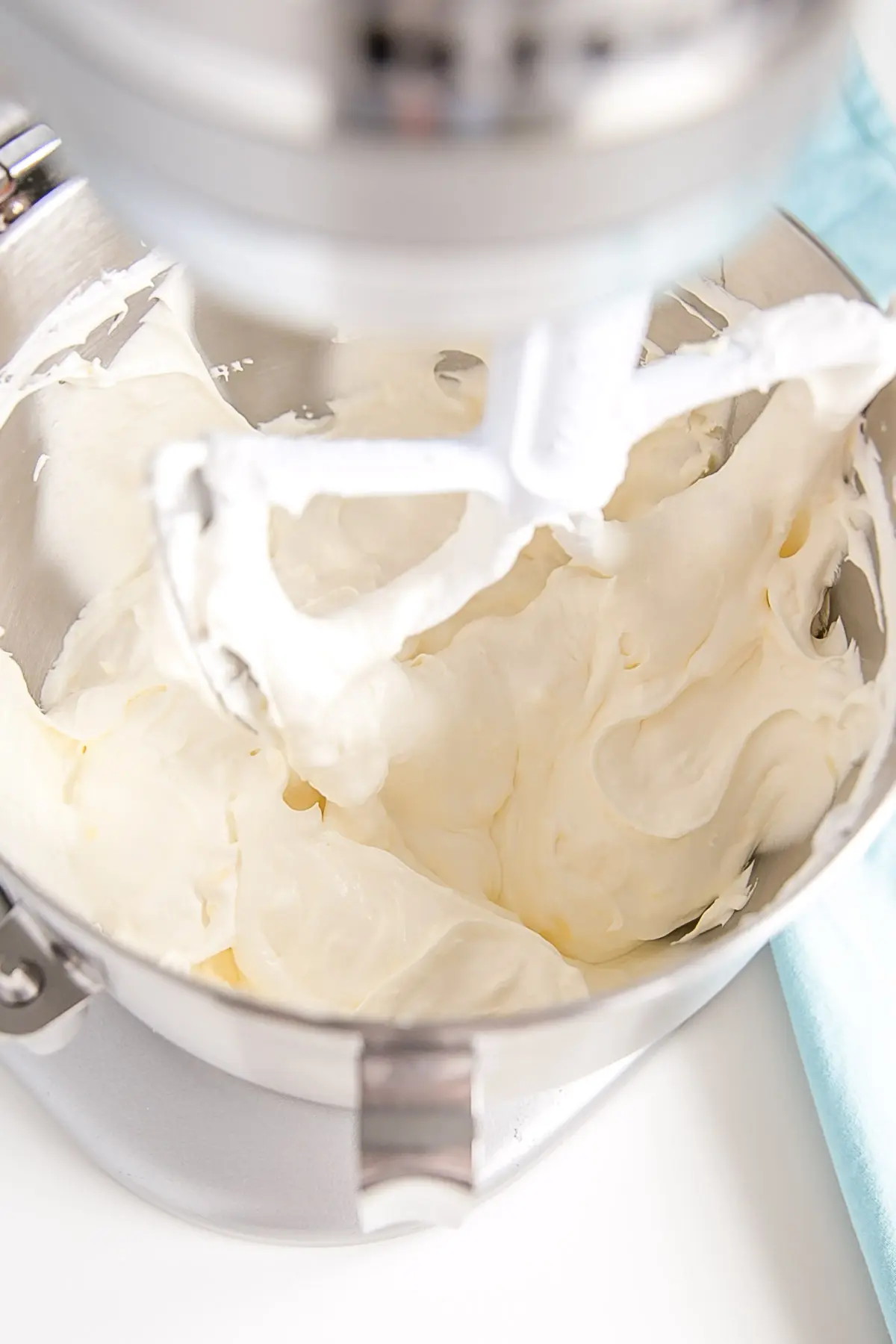
And it often curdles:
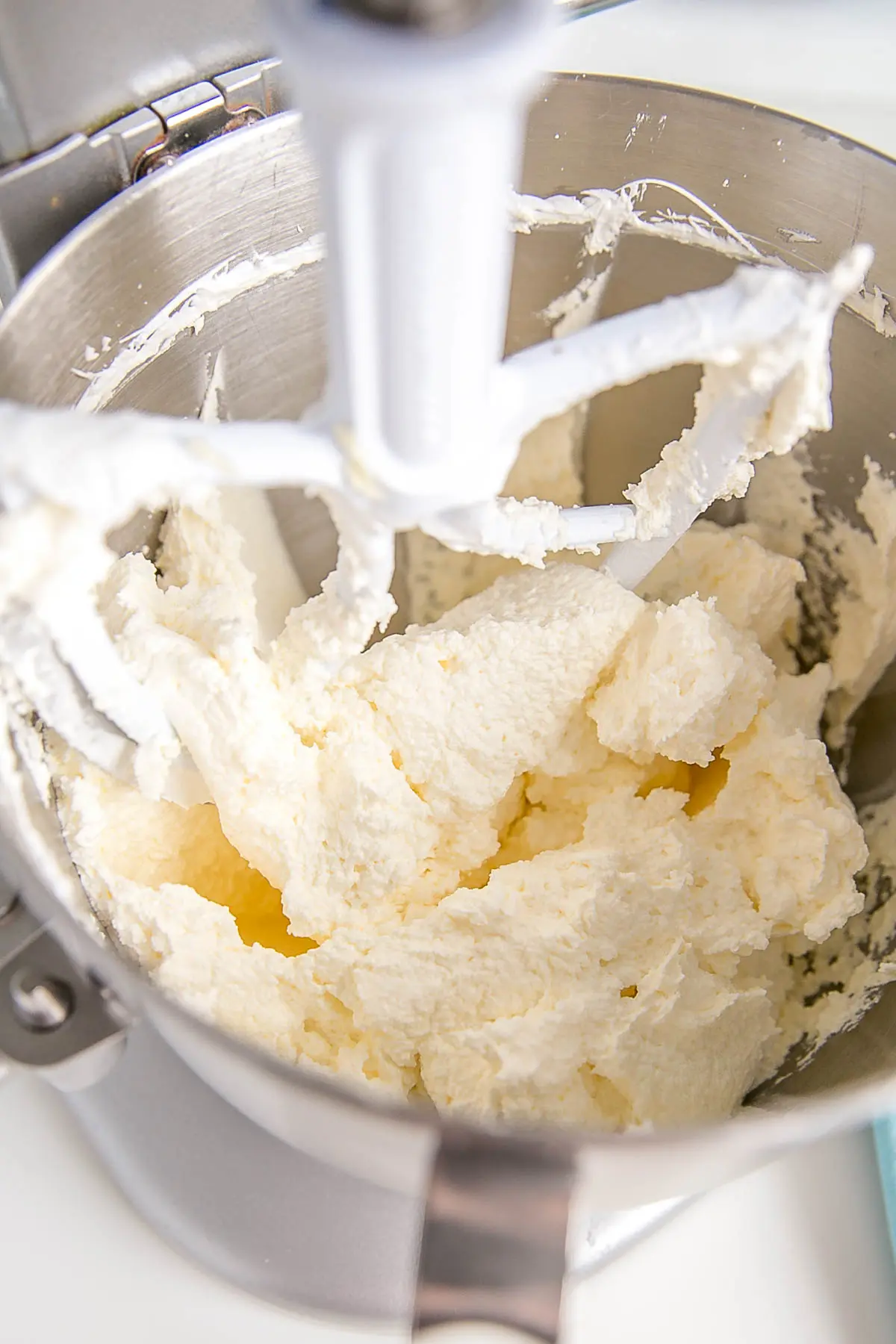
I find it best to walk away and come back after 5 mins to a (hopefully) perfect SMBC. See the Troubleshooting section below if this is not the case.
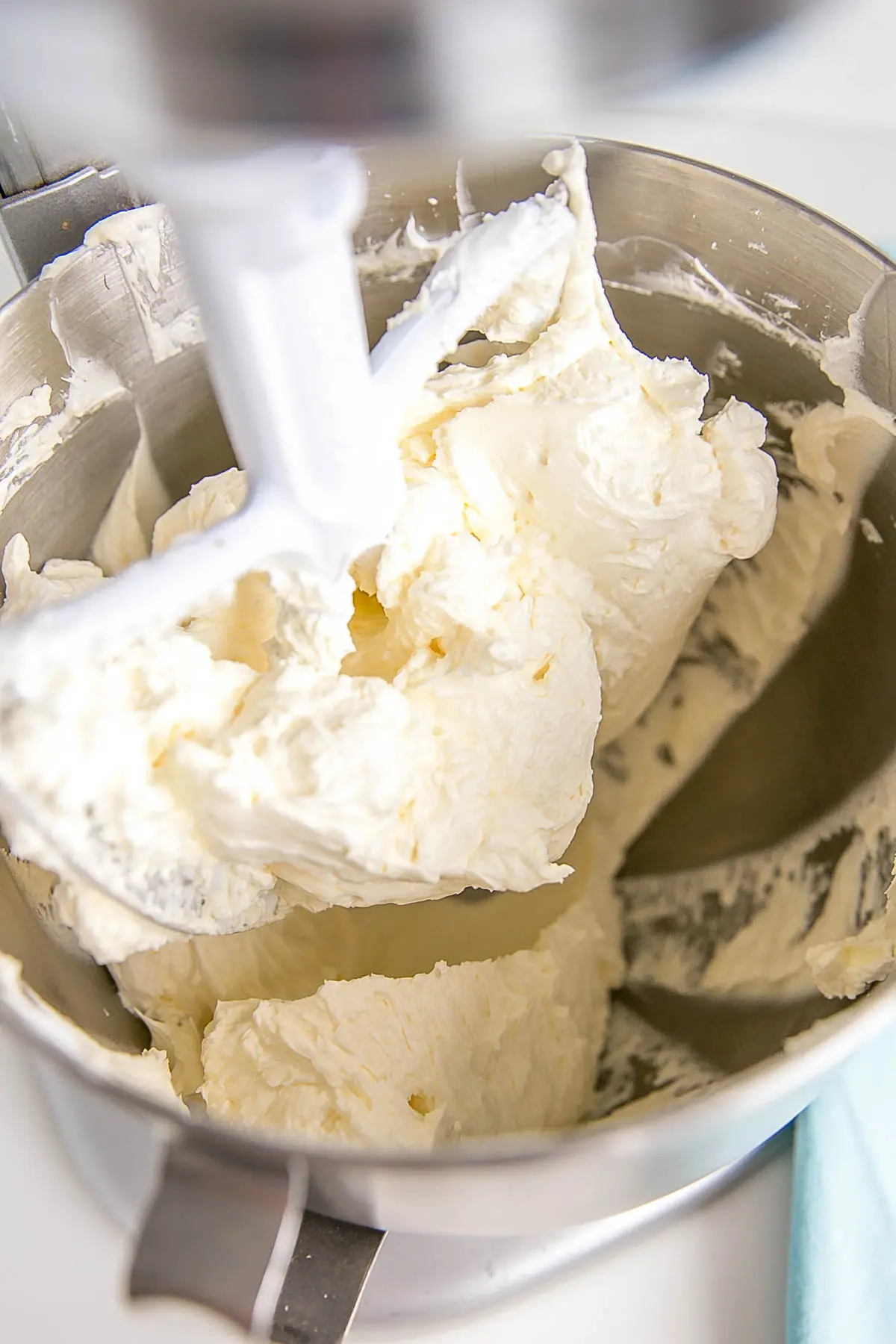
Once the buttercream is completely smooth, fluffy, and creamy, you can add in your flavorings (see below for a list of recipes).
How do I make my buttercream white?
This is a bit off topic, but also comes up often. SMBC can turn out a bit yellow depending on how much butter you use. This is not always a desirable effect, especially if you’re going for an all white cake.
The trick is to neutralize the yellow color by adding a bit of blue/violet to it.
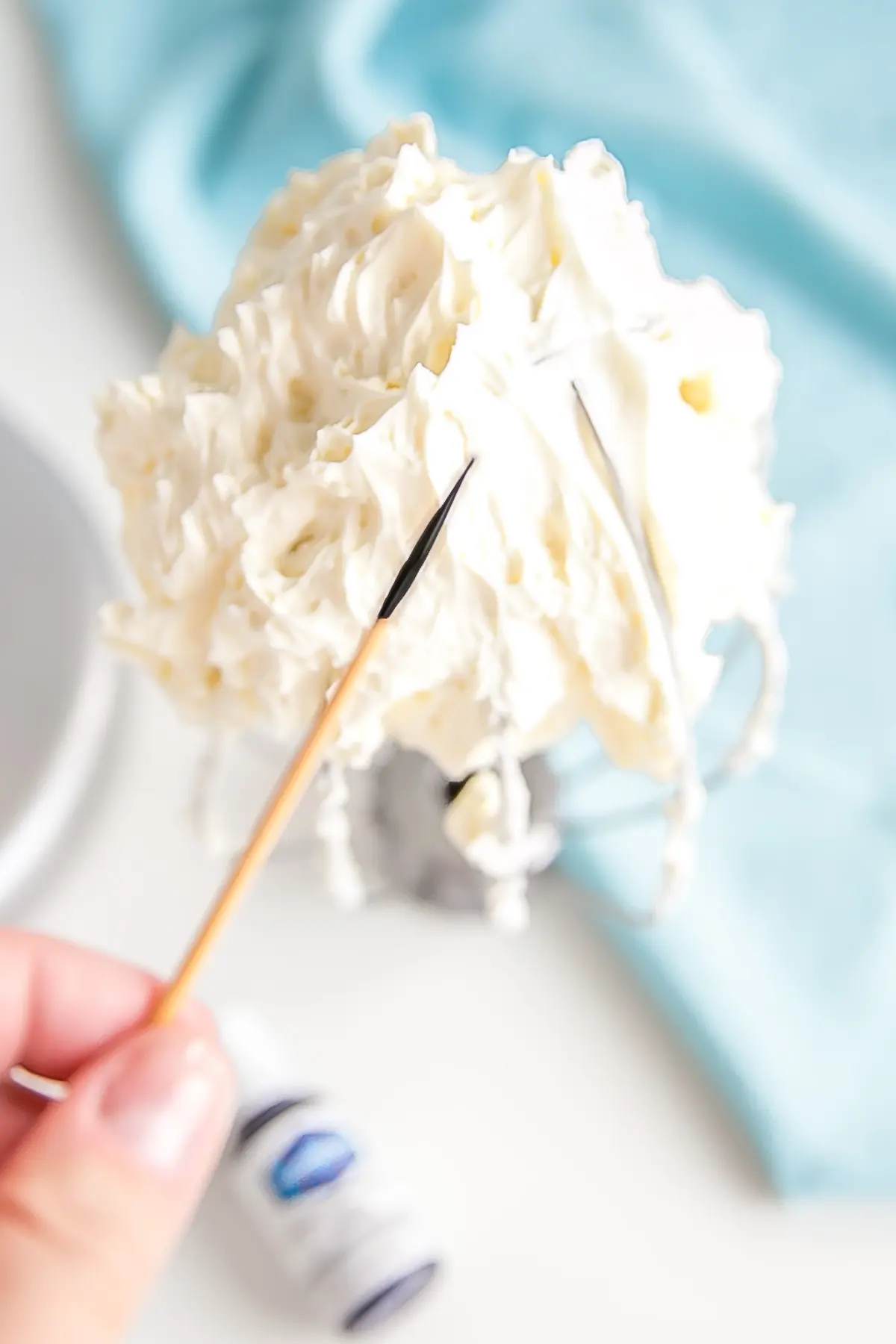
And I mean a bit. The amount on the toothpick above is more than I added. I basically swiped the toothpick over the buttercream on the whisk, so really only used one side of it.
I’d recommend starting with less and adding more as needed, or you’ll end up with a grey or bluish-looking buttercream.
Once the gel has been added (I used Americolor Violet), give the buttercream a good whip and you’ll see the yellow tint fade away. Add more color gel as needed.
Be sure to check out my detailed tutorial on How to Make Buttercream White for other tips.
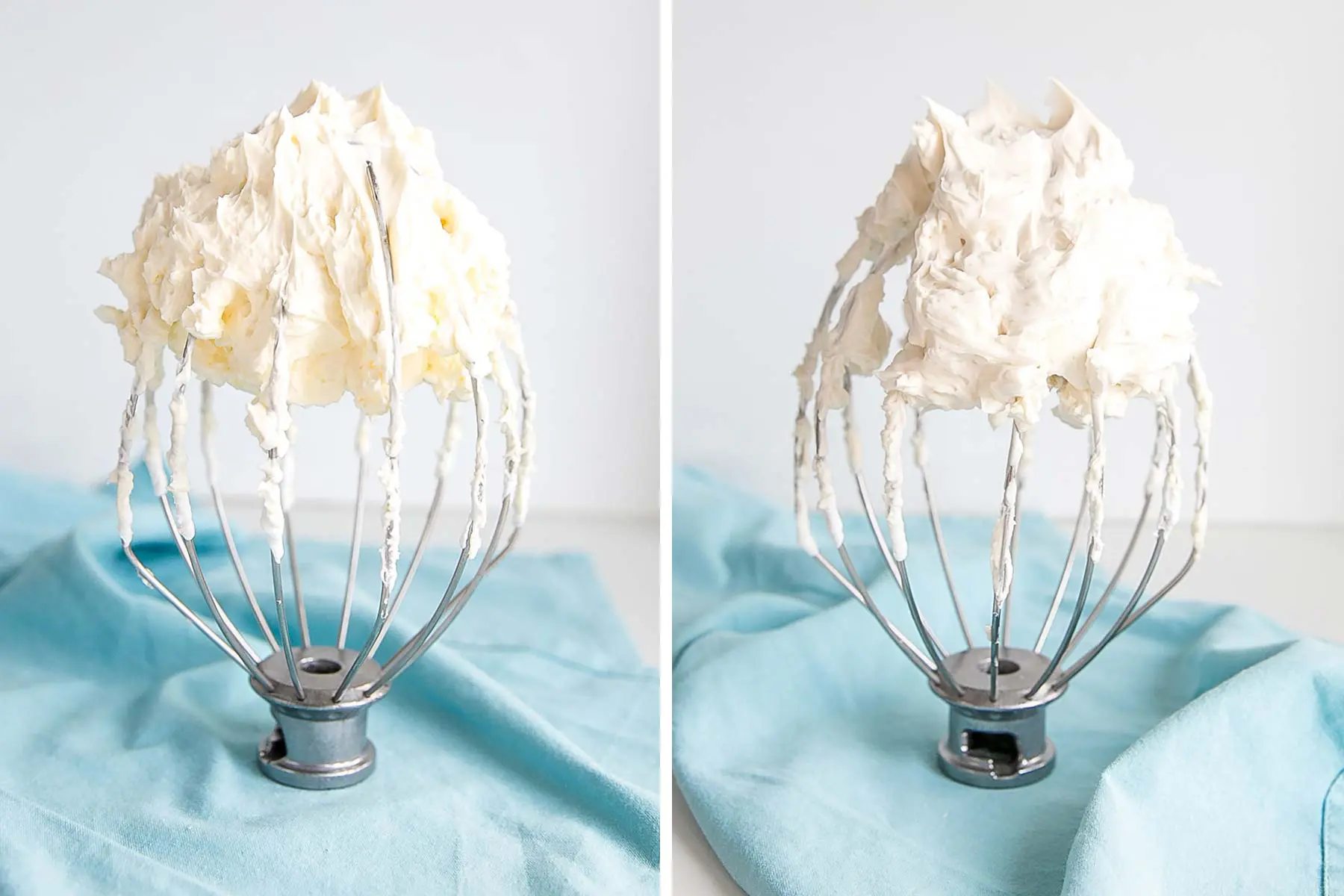
Troubleshooting Swiss Meringue Buttercream
Swiss meringue buttercream can be finicky. It’s temperamental and can cause a whole lot of unnecessary stress. The good news is that as long as your meringue was stiff before the butter was added, whatever issue you encounter after that is fixable.
Here are some common issues you may run into while making Swiss meringue buttercream, as well as my tips and suggestions on how to avoid/fix them:
- My meringue won’t whip up. This is either due to grease or egg yolks or both. See Step #1 of the tutorial above.
- My buttercream looks curdled. This is a common step when making SMBC. Once all the butter is added, it often goes through a phase where it looks curdled. If you keep whipping it, it will come together.
- My buttercream still looks curdled. If the temperature of the butter is too cold, it can be harder to get it to come together. You can either put it over a double boiler again like in Step #2, or warm the sides of the bowl with a hair dryer. One time, I had thawed some frozen SMBC and I didn’t completely bring it to room temperature before rewhipping. It looked like cottage cheese soup in my mixer. I thought it was a lost cause, but I heated the bowl a bit with a hair dryer and walked away for a few mins. When I came back it had come together perfectly! If you use the double boiler method, warm the buttercream just until the very edges start to melt, and then rewhip. You can also try to microwave 1/4 cup of the buttercream for a few seconds then drizzle it back into the buttercream with the mixer on low speed until it comes together.
- My buttercream is soupy. This is the opposite problem of curdled buttercream. This occurs because either the meringue was too warm when you added the butter or your butter was too soft, or both. Pop the whole bowl and whisk into the fridge for 20mins and then rewhip. Depending on how warm it was, you may need a couple of sessions in the fridge.
- My buttercream is grainy. This is due to the sugar not being dissolved properly in Step #4 above. Once the meringue is whipped, there is nothing you can do to fix this. It’s best to start over.
- My buttercream is greasy. SMBC is more buttery than an American buttercream, but it should not feel greasy. If you haven’t added more butter than the recipe calls for and your meringue was stiff, then the greasiness is likely due to the buttercream not being whipped for long enough. It’s also good practice to rewhip the SMBC if it’s been sitting out on the counter for a while.
- The buttercream gets hard in the fridge. This is normal. Just like the butter it’s made from, it will firm up to the consistency of butter in the fridge. When you let it come to room temperature it will soften again.
- It tastes too buttery. Some people just don’t like meringue buttercreams — they’re not for everyone! But the buttercream should be light and fluffy, not thick and greasy. If yours tastes like you’re eating a stick of butter, perhaps your meringue wasn’t whipped to stiff peaks before adding butter, or the butter was too cold, in which case it just needs some more whipping. Or you added too much butter.
Frequently Asked Questions
- Can I make Swiss meringue buttercream in advance? Yes! You can leave it at room temperature for a day or two, refrigerate for up to two weeks, or freeze it for up to 3 months. Be sure to store it in an airtight container. You must bring the buttercream completely to room temperature and rewhip before use. If the buttercream separates, it was still a bit too cold. See Step #3 above in the Troubleshooting section.
- How do I thaw my buttercream? Thaw it on the counter. It will be too hard if you thaw it in the fridge. I thaw mine overnight. Rewhip before use. See above.
- How long does Swiss meringue buttercream last? It will last for a day or two at room temperature, 2 weeks in the fridge, and 3 months in the freezer. Be sure it is properly stored in an airtight container or a freezer bag.
- Is Swiss meringue buttercream safe to eat? Yes. If you cook the eggs to 160F the buttercream will be safe to eat.
- Can I flavor Swiss meringue buttercream? Yes. Once the buttercream has come together, you can add any kinds of flavorings, extracts, powders, or chocolate — see list below for a list of recipes.
- Can I color Swiss meringue buttercream? Yes. Though SMBC is more difficult to color than an American buttercream. The color doesn’t take as well, so you may need more color gel. Be careful not to add too much, as the buttercream may split. You may want to look into powdered food coloring if you’re wanting to do very vibrant colors. I don’t recommend using liquid food coloring as it is not intense enough an can cause the buttercream to split. For more tips on getting rich, dark colors with SMBC see my Chocolate Peppermint Cake post.
- I don’t have a stand mixer. Can I use my hand mixer to make Swiss meringue buttercream? You probably can, but I do not recommend it. You’d be whipping forever! First to cool the meringue, and then when the butter is added. It can be a 10-15min process with a stand mixer, so I imagine it could take twice as long. So… doable if that’s all that you have at your disposal, but just know you’re in for a long haul.
Swiss Meringue Buttercream Recipe
The recipe I’m including below is the standard SMBC recipe that I use, though I tend to experiment a lot with it and sometimes add an extra egg white or use a bit less butter, depending on the amount of frosting I need.
I haven’t run into any issues doing this, but it’s important not to add more butter than the recipe calls for unless you’re also increasing the egg whites & sugar.
Swiss Meringue Buttercream Variations
- Blueberry (or any kind of berry)
- Brown Butter
- Brown Sugar
- Caramel
- Chocolate
- Cinnamon
- Coconut
- Dulce de Leche
- Espresso
- Honey
- Maple
- Mint
- Mocha
- Peanut Butter
- Vanilla
- White Chocolate
I hope you’ve found this guide helpful and that it’s given you the courage to give Swiss Meringue Buttercream a try! It truly is one of the most delicious buttercreams out there.
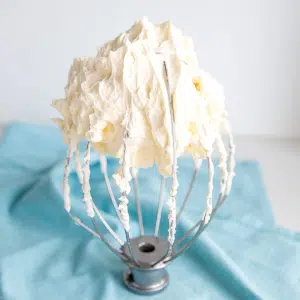
Swiss Meringue Buttercream Recipe
- 6 large egg whites
- 2 cups granulated sugar
- 2 cups unsalted butter softened but still a bit firm, cubed
- vanilla or other flavoring to taste see post for options
Swiss Meringue Buttercream
- Place egg whites and sugar into the bowl of a stand mixer, whisk until combined.
- Place bowl over a pot with 1-2" of simmering water and stir constantly with a whisk until the mixture is hot and no longer grainy to the touch or reads 160F on a candy thermometer (approx. 3mins)
- Place bowl on your stand mixer and whisk on med-high until the meringue is stiff and cooled (the bowl is no longer warm to the touch (approx. 5-10mins)).
- Switch to paddle attachment (optional). Slowly add cubed butter and mix until smooth.
- Add flavorings as desired whip until smooth.
- This recipe makes enough to frost a two layer 8″ cake or a three layer 6″ cake.
- The recipe can be made with 3 cups of butter instead, if you need more frosting.
- See blog post for tips and troubleshooting.
Updated Nov 2, 2022. Originally published Jan 2, 2019

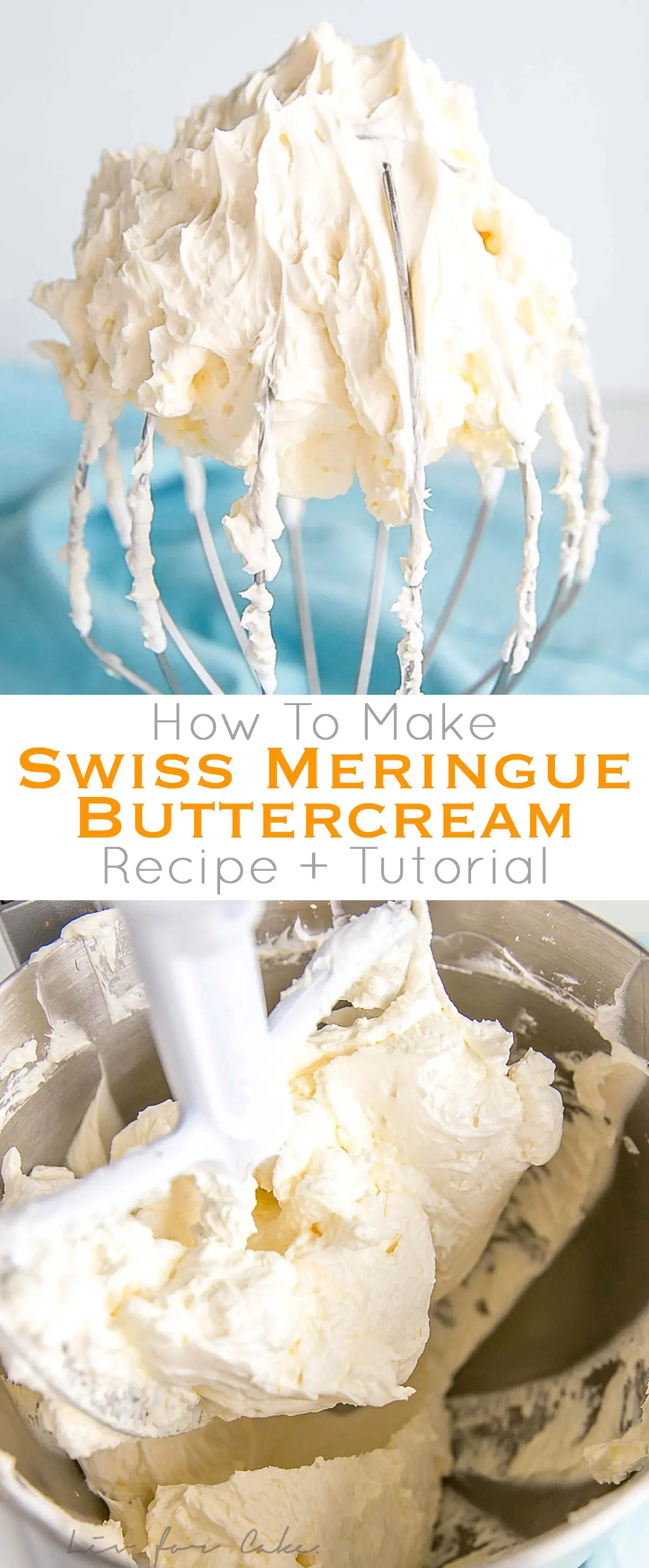
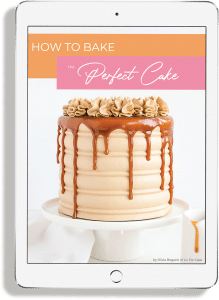
Olivia says
I love this tutorial, it is one of the easiest to follow that I have found! I am getting ready to make a 4 layer 8″ cake using this as the frosting and decorating. By how much would you suggest I alter the measurements? I don’t want to mess it up and waste any ingredients so I thought I would ask for advice before I take a go at it!
Olivia says
Hi Olivia! So happy you found this helpful. I would double the recipe for that size cake.
Rachel Martin says
Thank you so much for this recipe! I’ve tried and failed 2 time before using different recipes and ended up with scrambled sweetened egg whites. This recipe worked so well. I multiplied it by 1.5 to cover a 3 layer 9 inch cake and had maybe a cup of frosting left over. Used your recipe for cookie butter frosting so I added 1/2 cup of cookie butter to the last step as I was making a Speculoos/Biscoff cake. Frosting turned out beautifully. The step by step instructions were spot on.
Olivia says
Hi Rachel! I’m so happy to hear it worked well for you and that you loved it. Thank you for your tips!
Julia says
Any tips for someone who doesn’t have a stand mixer with a stainless steel bowl, but instead, a industrial Bosch mixer?
Olivia says
Hi Julia! I haven’t used one of the Bosch mixers so I can’t say for sure. You can always heat the egg whites and sugar in a stainless steel bowl and then transfer them into the mixer.
Patty says
Followed this recipe step by step and I was a success! I was always intimidated to make SMBC, so I made sure I read all the troubleshooting notes.
I noticed that some of my butter was too soft after adding a couple of cubes into the mix, so I put in a metallic container and in the freezer and each cube came out of the freezer. It actually fixed itself as I dropped more colder cubes
Thanks
Olivia says
Hi Patty! So happy to hear you nailed this on your first try. Good tip about the butter!
Yuan says
Thank you so much for such detailed instructions! I can’t believe I got it right the first time! Amazing recipes ! Thank you!
Olivia says
Yay! So happy to hear you found the instructions helpful 🙂
Karlene says
Hi Olivia,
How long does the swiss buttercream frosting stay fresh for? I want to make it on Saturday to ice a cake and then serve on Sunday. Also any dramas putting it in the fridge? Thank you so much
Olivia says
Hi Karlene! I talk about all of this in the post.
Kristin Koss says
Hi I want to add chocolate if so how much can I use melted chocolate. Thanks Kristin
Olivia says
Hi Kristin! Yes, I talk about this in the post and link to a chocolate version. Be sure the melted chocolate is completely cooled before using.
Brittany says
How would you achieve a lemon flavored SMBC?
Olivia says
Hi Brittany! My favorite way is to incorporate some lemon curd into the frosting: https://livforcake.com/lemon-curd/
Tt says
I added vanilla & caramel for flavoring. I love the idea of a paddle but to be honest I just used the whisk. Worked great. Thanks.
Olivia says
Glad you liked it, thanks Tt!
Cheryl says
I absolutely love your recipes and your extent of detail. I have two questions for you:
1. You stated that you use this recipe as the base for your flavored SMBC’s. I’ve tried and enjoyed the coconut version but just noticed that in it, you use 1/2 cup less sugar and 1/2 cup less butter but same amount of egg whites when adding 1/4 cup coconut milk powder. Why is that? How would adding 1/4 cup coconut milk powder to this recipe be different?
2. If I have multiple mixer bowls, could I transfer the cooked egg whites to a room temp bowl before whisking, or does the residual heat of the bowl play a part in the process?
Olivia says
Hi Cheryl! I have experimented with my SMBC over the years trying different amounts based on the amount of frosting I needed. This recipe here is a good standard base recipe. For your second question, that is a good question. I think the heat is just to cook the whites to a safe, edible temperature. I would give it a try and see if you notice a difference in how the meringue whips up.
Aysha says
Hello, how many cupcakes would this recipe cover. Thank you
Olivia says
Hi Aysha! It should cover 18-24 depending on size.
Asia says
Hello Liv!
I love this recipe for SMBC and have made it many times with fantastic results. However, I always have to put the bowl of meringue in the fridge after whipping to stiff peaks to get it to cool to the right temperature. I’ve whipped the meringue for up to an hour but it never dips below 90F. My buttercream still turns out great after I refrigerate until meringue is room temp and then add room temp butter, but putting it in the fridge is definitely a hassle. How do you get it to cool after just 10 minutes of whisking?
Olivia says
Hi Asia! Strange that it never cools down. Do you use a glass bowl by chance? Those tend to retain the heat more. Sometimes if I want to speed up the cooling down I place a bag of frozen peas under the bowl while it’s whipping. Give that a try?
Mandi Moore says
Followed it to a T as my first Swiss buttercream. Epic disappointment. I am not sure what went wrong. I did the blend until stiff peaks(reminded me of whisking marshmallows lol) as soon as I added the butter..flat and soupy. Butter was room temp and still able to be cubed. Ant suggestions?
Olivia says
Hi Mandi! Soupy is definitely a temperature thing. I suspect the meringue was still too warm. I give tips on how to fix this in the post.
Michelle Dell says
Love this SMBC but every time I am heating the whites and sugar for nearly 10 mins to get hot to touch/160 then the mixer bowl is so hot it takes a really long time for it to cool while whisking the whites (20 mins or more) before adding the butter. Any advice please? Is it better to keep whisking until cool or as soon as stiff peaks stop whisking until the bowl is also cool? Thx!
Olivia says
Hi Michelle! It can take a long time to cool the bowl for sure. I just keep whipping it but you can (once the merinue is stiff) place a bag of frozen peas or similar around the bottom of the bowl briefly to speed up the cooling.
Meg says
Your note at the end says: recipe can be made with 3 cups of butter if you need more frosting. I am assuming you do not mean just add another cup of butter to the existing recipe, but increase all ingredients proportionally?
Just checking since I do need more than 6 cups.
Olivia says
Hi Meg! I do actually mean to add another cup of butter. That is the standard recipe I learned in pastry school but I reduce the butter to 2 cups as this is enough for most cakes. You can totally scale up the ingredients too though which will give you even more butterceam.
jennifer says
I’m about to dive in on a practice run of the lemon elderberry wedding cake for my niece’s upcoming event. I’m a skilled, experienced home baker but don’t ever seem to have/plan the time for multi-step frostings. It’s just one thing I’ve managed to not learn til today. Lol. So here we go! The whole day is set aside. 🙂 thank you for this excellent tutorial. I feel ready to go! 🍋
Olivia says
Hi Jennifer! Good luck to you! I am sure you will nail it. Let me know how it goes 🙂
Ivayla says
I don’t think I could ever accurately describe the level of disappointment when you check your meringue after whipping and it has the most perfect stiff peaks you have ever seen… and it’s grainy. 🙁 Don’t skip the finger test people, even with a thermometer! Any recipes for grainy meringue? I’d hate to just throw it out.
But 5 stars on the recipe and tutorial – this is my go-to, and it usually works out so well!
Olivia says
Hi Ivayla! Ugh I have been there with a grainy meringue. You think it will keep dissolving as you whip it but it does not. So disappointing. I haven’t found a way to save it. Instead of using it in a buttercream you could try baking up some merinue cookies instead. I think they will still be grainy though but maybe not as noticeable? Glad you love the recipe! 🙂
Chelsye says
Thank you so much for this recipe. It is now my go to recipe and my family’s favorite. I’ve tried caramel, chocolate, vanilla, white chocolate, peanut butter and biscoff flavorings and each time it comes out perfect. I live in Hawaii and it holds up nicely even in the humidity. Thanks again!
Olivia says
Thanks so much Chelsye! I’m so happy you love it 🙂